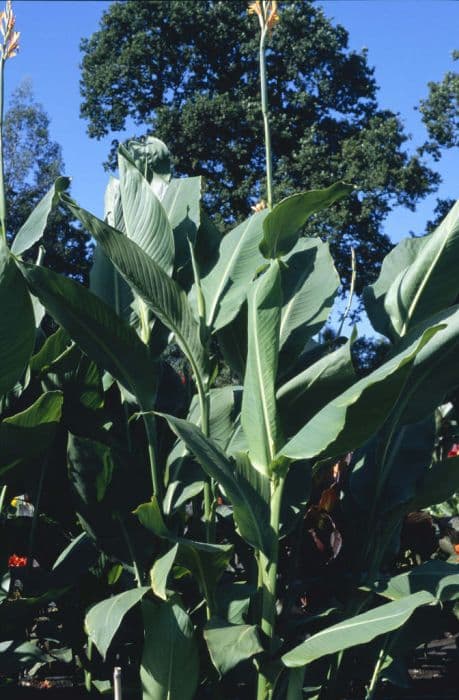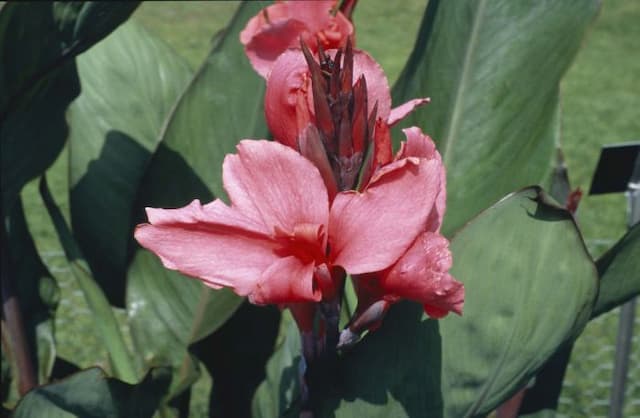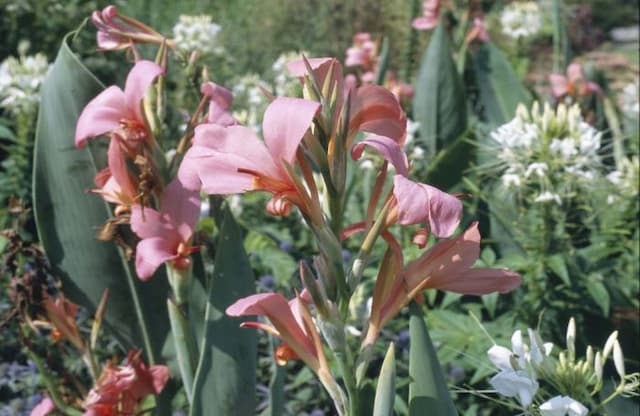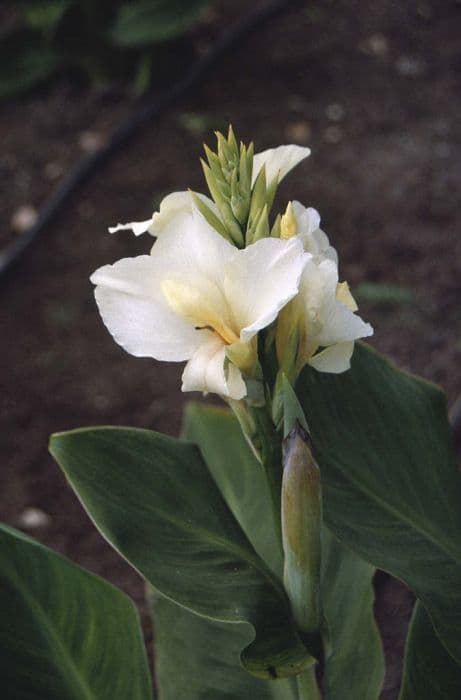Banana Canna Canna 'Musifolia'

ABOUT
Canna 'Musifolia', widely known as Canna or Canna Lily, is a vibrant and lush perennial that brings a tropical flair to any landscape. This plant boasts large, broad leaves that are banana-like in shape and texture, often in a striking deep green hue that can sometimes have a bronzy or reddish tint. Its leaf edges may show a hint of a wavy or undulating pattern, adding to the plant's dramatic presentation. The flowers of the Canna Lily are equally showy, featuring bold, bright colors that can range from fiery reds and oranges to sunny yellows or rich pinks. These blossoms are asymmetrical, with each petal flaring outward from a central roll or spiral that resembles a turban, giving them an exotic and ornamental look. The flowers cluster at the top of tall, sturdy stalks that rise above the foliage, creating a layered canopy effect in the garden. Canna 'Musifolia' is known for its lush, tropical appearance and its ability to add height, texture, and a burst of color to a garden setting. The combination of its dramatic leaves and striking flowers make it a popular choice for gardeners looking to create a visual impact with their plant arrangements. This plant is also frequently used in large containers, where its impressive foliage can serve as a backdrop for other flowering plants.
About this plant
 Names
NamesFamily
Cannaceae
Synonyms
Banana Canna, Musifolia Canna, Large-leaf Canna, Giant Canna
Common names
Canna 'Musifolia'
 Characteristics
CharacteristicsLife cycle
Perennials
Foliage type
Deciduous
Color of leaves
Green
Flower color
Red
Height
6-8 feet (1.8-2.4 meters)
Spread
2-3 feet (0.6-0.9 meters)
Plant type
Herb
Hardiness zones
7-10
Native area
Central America
Benefits
 General Benefits
General Benefits- Ornamental Appeal: Canna 'Musifolia' features striking foliage and blooms that add visual interest to garden designs.
- Low Maintenance: This plant is relatively easy to care for, requiring minimal maintenance once established.
- Fast Growth: Canna 'Musifolia' grows quickly, providing rapid gratification in landscape projects.
- Drought Tolerance: Once established, it can tolerate periods of low water availability, making it suitable for xeriscaping.
- Attracts Pollinators: The flowers attract hummingbirds and bees, supporting local ecosystems.
- Versatility: It can be used in a variety of garden styles, including tropical and traditional landscapes.
- Soil Adaptability: This canna variety can adapt to a range of soil conditions, although it prefers moist, well-drained soils.
- Heat Resistance: It is capable of withstanding high temperatures, making it ideal for warm climates.
 Medical Properties
Medical PropertiesThis plant is not used for medical purposes.
 Air-purifying Qualities
Air-purifying QualitiesThis plant is not specifically known for air purifying qualities.
 Other Uses
Other Uses- Canna as a Bioplastic Resource: The starch-rich rhizomes of the Canna plant can be processed to create biodegradable plastics, offering a more sustainable alternative to traditional petrochemical plastics.
- Edible Flowers: The flowers of the Canna plant are not only ornamental but also edible, providing a colorful addition to salads and desserts.
- Natural Dye: Canna leaves and flowers can be used to produce natural dyes for coloring fabrics and handicrafts.
- Living Fences: Due to its dense foliage, Canna can be planted in rows to create natural privacy screens or living fences, delineating spaces with vibrant color and texture.
- Animal Fodder: The foliage of Canna, rich in nutrients, can be used as fodder for livestock in regions where other fodder crops are scarce.
- Biofabrication: Innovative research explores incorporating plant cellulose from Canna into biofabricated materials, such as textiles and composites.
- Soil Erosion Control: The robust root system of Canna makes it ideal for stabilizing soil and preventing erosion along riverbanks and slopes.
- Aquatic Landscaping: Canna varieties that tolerate wet conditions can be used for aquatic landscaping, enhancing the aesthetics of ponds and water features while providing habitat for wildlife.
- Compost Material: Canna leaves and stems are useful additions to compost piles, decomposing quickly and adding valuable nutrients back into the soil.
- Themed Gardens: Canna plants can be prominently featured in tropical and subtropical-themed gardens for educational and aesthetic purposes, showcasing plant diversity within specific climate zones.
Interesting Facts
 Feng Shui
Feng ShuiThe Canna plant is not used in Feng Shui practice.
 Zodiac Sign Compitability
Zodiac Sign CompitabilityThe Canna plant is not used in astrology practice.
 Plant Symbolism
Plant Symbolism- Exotic Beauty: The Canna 'Musifolia', commonly known as Canna Lily, often symbolizes exotic beauty due to its large, colorful flowers and tropical appearance.
- Vibrancy: With its vivid blooms, the Canna Lily is associated with vibrancy and a lively spirit, embodying the energy and passion of life.
- Confidence: The bold stance and bright colors of the Canna Lily can represent confidence and pride, encouraging one to stand tall and be noticed.
- Creativity: Often used in artistic and creative settings, the Canna Lily can symbolize creativity and inspiration, suggesting a flourish of new ideas and originality.
 Water
WaterCanna 'Musifolia', commonly known as Banana Canna, prefers consistent moisture and should be watered deeply. Aim to water the plant when the top inch of soil feels dry to the touch, which might mean watering every few days during hot, dry periods, and less frequently during cooler or rainy spells. Generally, Banana Canna benefits from approximately 1 to 1.5 inches of water per week whether from rainfall or manual watering. If the plant is in a container, ensure that any excess water can drain away to prevent root rot. One or two gallons per week should suffice for an established plant, depending on weather conditions, but always adjust based on soil moisture levels.
 Light
LightBanana Canna thrives in full sunlight where it can receive at least 6 to 8 hours of direct sunlight daily. It can tolerate partial shade, but flowering will be less prolific. The best spot for this plant is in a location where it will get ample morning light and, if possible, some protection from the intense afternoon sun, which can sometimes scorch the leaves.
 Temperature
TemperatureBanana Canna does well in warm temperatures and can tolerate a range from about 60°F to 90°F. It is not frost-hardy and should be protected or moved indoors if temperatures are expected to fall below 50°F. The ideal temperature range for optimal growth and flowering is between 70°F and 85°F.
 Pruning
PruningBanana Canna should be pruned to remove spent flowers and damaged leaves, which encourages new growth and more blooms. Pruning can be done throughout the growing season as needed. After the first frost, cut back the foliage to ground level as the plant dies back for winter dormancy. The best time for major pruning is in late winter or early spring before new growth starts.
 Cleaning
CleaningAs needed
 Soil
SoilFor the Canna Lily, a well-draining, fertile soil with a pH of around 6.5 to 7.0 is ideal. A mix containing equal parts of garden soil, peat, and perlite or sand can support healthy growth. Regularly enrich soil with compost or a balanced fertilizer for best results.
 Repotting
RepottingCanna Lilies should be repotted every couple of years or when they outgrow their current pot. To ensure vigorous growth, divide the rhizomes during repotting. This also helps to rejuvenate the plant and control its size.
 Humidity & Misting
Humidity & MistingCanna Lilies thrive in moderate to high humidity levels, but they are adaptable and can tolerate some variations. Aiming for around 50-70% relative humidity is a good range for these plants.
 Suitable locations
Suitable locationsIndoor
Place in bright, indirect light and keep soil moist.
Outdoor
Plant in full sun, enrich soil, and water regularly.
Hardiness zone
7-11 USDA
 Life cycle
Life cycleThe life cycle of the Canna 'Musifolia', commonly known as the Banana Canna, begins with seed germination, where warmth and moisture trigger the emergence of a small shoot and roots. The seedling stage follows as these shoots and roots grow into a young plant; this period of rapid growth requires ample sunlight and water. The vegetative stage is marked by the development of large, banana-like leaves and a sturdy stem, preparing the plant for flowering. During the flowering stage, the Banana Canna produces tall spikes adorned with bold, colorful flowers, usually red, orange, or yellow, which can attract pollinators like bees and hummingbirds. After pollination, the plant enters the fruiting stage, producing capsules that contain seeds, which can be harvested when dry and mature. Finally, as a perennial, the Banana Canna enters a period of dormancy in colder months if not in a tropical climate, where the foliage dies back, and the rhizomes remain dormant until conditions are favorable again for growth.
 Propogation
PropogationPropogation time
Spring-Early Summer
Canna 'Musifolia', commonly known as Canna Lily or Musa-leaf Canna, is typically propagated through division of its rhizomes. The most popular method involves separating the rhizomes during the plant's dormancy period, usually in late winter to early spring. Gardeners should carefully unearth the clump and use a sharp knife to divide the rhizome into sections that have at least one eye or bud. Each section is then planted directly into well-draining soil, about 2 to 3 inches (5 to 7.5 centimeters) deep. The divisions should be spaced about 1 to 2 feet (30 to 60 centimeters) apart to allow room for growth, and they usually start producing new shoots within a few weeks under the right conditions of warmth and moisture.









